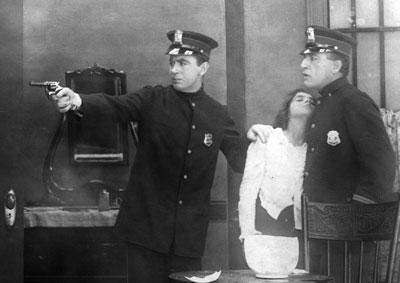Musical accompaniment provided by Cliff Retallick.
You are here
Traffic in Souls (1913);
Where Are My Children? (1916)

Preserved by the Library of Congress.
Traffic in Souls (1913)
Directed by George Loane Tucker
The issue of underage prostitution exploded in American public consciousness in 1910 with the publication of Reginald Wright Kaufmann’s sensationalist novel, "The House of Bondage," which went through ten printings in as many months. Prostitution then became a national obsession with the release of the “Rockefeller Commission Report on White Slavery,” a supposed source for Traffic in Souls, co-written and directed by George Loane Tucker. In this seminal melodrama, a young woman accepts a date with a “nice” young man, and ends up sold to a “white slavery” ring, secretly run by a well-known philanthropist. Desperate to find her, the victim’s sister takes a job with the philanthropist and, with the help of her boyfriend, a police detective, exposes his nefarious scheme. Whatever actual truth Tucker’s depiction of this criminal world may hold, the fact that it is a member of the ruling class that controls public vice— and the working class his victims—testifies to the class bias of early cinema audiences, a trend in this new popular entertainment, also evidenced in D.W. Griffith’s early gangster film Musketeers of Pig Alley (1912), that was almost as alarming to some social reformers as prostitution itself.
Striking the right balance between civic education and salacious exploitation, however, Traffic in Souls earned a whopping $450,000 on a $5,700 investment. At one point, the film was being shown at 20 New York theatres simultaneously. Both film critics and Progressives praised its fast pace and social message. Produced by the Independent Motion Picture Company (IMP), Carl Laemmle’s production company, Traffic in Souls was the first feature length film distributed by Universal after its founding, and one of the first long form films produced in the United States. Ironically, the film’s success did little to convince Laemmle that features were the way of the future, so for several more years Universal continued making shorts, while others made the transition. Given that policy, Traffic was cast and shot in secret without the knowledge of IMP officials, then cut down to six reels by Jack Cohn and Walter McNamara, Tucker having left the country for England before the film’s post-production was completed. Finally, since the film was shot in real New York locations, it affords the modern viewer a unique window on to the past.
—Jan-Christopher Horak
Independent Moving Picture Co. Screenwriter: Walter MacNamara, G.L. Tucker. Cast: Jane Gail, Ethel Grandin, William Turner, Matt Moore, William Welsh.
35mm, silent, b/w, 88 min.
Preserved by the Library of Congress.
Where Are My Children? (1916)
Directed by Lois Weber, Phillips Smalley
An overzealous prosecutor accuses a local doctor of performing illegal abortions, unaware of his own wife’s complicity in helping wealthy socialites, including herself, avoid pregnancy. Previously, the prosecutor had supported a doctor convicted of sending birth control literature through the mails (a subplot based on the sensational 1915 trial of suffragette and feminist Margaret Sanger). Thus, writer-director Lois Weber’s Where Are My Children? served up mixed messages: on the one hand, condemning abortions, while on the other, advocating birth control, especially for working class women. Not surprisingly, as did Traffic in Souls, Weber’s content and themes caused a huge controversy and was actually banned in some states, though film critics generally praised the film for its sensitive handling of difficult moral and social issues. Where Are My Children? was also Universal’s biggest moneymaker of 1916.
Though little known today, except in film academic circles, Lois Weber was one of the most powerful women in Hollywood in this time period. She was an outspoken feminist and social reformer who consciously used her films for social advocacy, and like D.W. Griffith, controlled every aspect of production from script to post-production. In 1916 alone, Weber directed no less than 10 films for Universal. The success of Children and other films allowed Weber to become the first American woman to own her own film studio, while continuing to distribute through Universal. She was not, however, unique at the studio, where a whole cadre of women directors worked in the 1910s, including Grace Cunard, Cleo Madison, Ida May Park, Ruth Stonehouse, Elsie Jane Wilson, and Ruth Ann Baldwin. However, by 1920, as Marc Cooper has demonstrated, they had been driven out of director’s chairs and into “feminine” film professions, like scriptwriting and editing. In 1993, Where Are My Children? was named to the Library of Congress’ National Registry of this country’s most significant film works.
—Jan-Christopher Horak
Universal Film Mfg Co. Screenwriter: Lois Weber. Cinematographer: Al Siegler, Stephen S. Norton. Cast: Tyrone Power, Helen Riaume, Marie Walcamp, Cora Drew, Rene Rogers.
35mm, silent, b/w, 62 min.
To report problems, broken links, or comment on the website, please contact support
Copyright © 2024 UCLA Film & Television Archive. All Rights Reserved






 Mobile Navigation
Mobile Navigation
